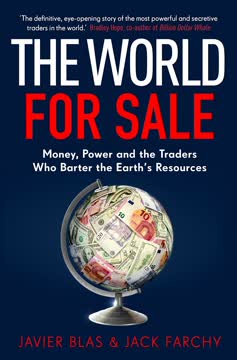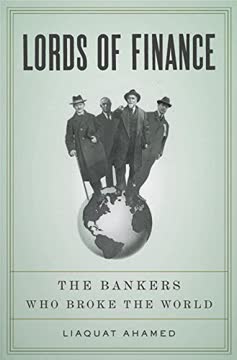النقاط الرئيسية
1. شكل المصرفيون المركزيون الاقتصاد العالمي في عشرينيات القرن الماضي
كان من المؤسف حقًا أن يتعرض أهم مصرفي مركزي في العالم لانهيار عصبي بينما كان الاقتصاد العالمي يغوص أعمق في السنة الثانية من كساد غير مسبوق.
قوة المصرفيين المركزيين. في عشرينيات القرن الماضي، كانت مجموعة صغيرة من المصرفيين المركزيين تتمتع بنفوذ هائل على الاقتصاد العالمي. ومن الشخصيات الرئيسية في ذلك الوقت:
- مونتاجو نورمان من بنك إنجلترا
- بنيامين سترونغ من الاحتياطي الفيدرالي في نيويورك
- هيلموت شاخت من الرايخسبنك
- إميل مورو من بنك فرنسا
اتخذ هؤلاء الرجال قرارات حاسمة بشأن أسعار الفائدة، وقيم العملات، والقروض الدولية التي شكلت المشهد الاقتصادي. وغالبًا ما أثرت علاقاتهم الشخصية، وتنافساتهم، وأيديولوجياتهم على خيارات السياسات التي كانت لها عواقب بعيدة المدى.
التحديات التي واجهت. واجه المصرفيون المركزيون:
- إعادة بناء النظام المالي الدولي بعد الحرب العالمية الأولى
- إدارة العودة إلى معيار الذهب
- التعامل مع ديون الحرب والتعويضات
- الاستجابة للأزمات الاقتصادية وتكهنات السوق
2. عودة معيار الذهب خلقت اختلالات اقتصادية
"سأجعلك المستشار الذهبي."
معضلة معيار الذهب. كانت العودة إلى معيار الذهب في عشرينيات القرن الماضي تُعتبر ضرورية للاستقرار الاقتصادي، لكنها خلقت مشاكل كبيرة:
- انضمت بريطانيا بمعدل مبالغ فيه، مما جعل صادراتها غير تنافسية
- حددت فرنسا سعر الفرنك بمعدل منخفض، مما منحها ميزة غير عادلة
- تراكمت الولايات المتحدة احتياطيات ذهبية مفرطة، مما خلق اختلالات عالمية
أدت هذه الفجوات إلى ضغوط انكماشية في بعض البلدان وساهمت في عدم الاستقرار الاقتصادي. كانت القواعد الصارمة لمعيار الذهب تحد من قدرة الدول على الاستجابة للتحديات الاقتصادية، مما زاد من تفاقم الكساد العظيم.
محاولات الإدارة. حاول المصرفيون المركزيون إدارة هذه الاختلالات من خلال:
- تعديلات أسعار الفائدة
- قروض دولية
- تدخلات في العملات
- اتفاقيات تعاون غير رسمية
3. أثرت التعويضات وديون الحرب على العلاقات الدولية
"Les Boches paieront" "الألمان سيدفعون" — كانت هذه العبارة تتردد.
عبء ديون الحرب. تركت الحرب العالمية الأولى شبكة معقدة من الديون والتعويضات التي أثرت على العلاقات الدولية:
- كانت ألمانيا مدينة بتعويضات ضخمة للحلفاء
- كانت الدول الأوروبية الحليفة مدينة للولايات المتحدة
- أصرت الولايات المتحدة على السداد بينما سعى الأوروبيون إلى مسامحة الديون
خلقت هذه الوضعية استياءً وعدم استقرار اقتصادي، خاصة في ألمانيا. حاولت خطة داوز لعام 1924 معالجة القضية من خلال إعادة هيكلة التعويضات الألمانية، لكنها في النهاية فشلت في حل المشاكل الأساسية.
العواقب:
- غذت القومية الاقتصادية
- ساهمت في عدم الاستقرار السياسي في ألمانيا
- أعاقت التعافي الاقتصادي في أوروبا
- أثرت على العلاقات الدبلوماسية بين الحلفاء
4. السياسات النقدية غذت التكهنات وعدم استقرار السوق
لم يدع سترونغ عمدًا أي أعضاء من مجلس الاحتياطي الفيدرالي إلى منزل ميلز.
قرار الاحتياطي الفيدرالي المصيري. في عام 1927، نظم بنيامين سترونغ من الاحتياطي الفيدرالي في نيويورك قرارًا بخفض أسعار الفائدة الأمريكية لمساعدة بريطانيا في الحفاظ على معيار الذهب. كان لهذا القرار عواقب غير مقصودة:
- غذى التكهنات في سوق الأسهم الأمريكية
- ساهم في تشكيل فقاعة سوقية
- خلق توترات داخل نظام الاحتياطي الفيدرالي
سلطت السياسة الضوء على التحديات المتمثلة في تحقيق التوازن بين القضايا الاقتصادية المحلية والدولية، فضلاً عن مخاطر اتخاذ القرارات الغامضة في المصرفية المركزية.
عواقب المال السهل:
- ارتفاع سريع في أسعار الأسهم
- زيادة في الإقراض الهامشي
- تزايد المخاوف بشأن استقرار السوق
- انتقادات لتركز الاحتياطي الفيدرالي على القضايا الدولية
5. أثرت التنافسات الشخصية على القرارات المالية العالمية
هيمن نورمان على الإجراءات، جالسًا في أحد طرفي غرفة المؤتمر على كرسي شرقي ذو ظهر مروحي.
أثر العلاقات. أثرت الديناميات الشخصية بين المصرفيين المركزيين بشكل كبير على قرارات السياسة:
- شكلت الصداقة الوثيقة بين نورمان وستронغ التعاون الأنجلو أمريكي
- أعاقت تنافسية نورمان مع مورو التنسيق الفرنسي البريطاني
- خلق أسلوب شاخت المواجهاتي توترات مع مصرفيين وسياسيين آخرين
غالبًا ما كانت هذه العلاقات تتجاوز الهياكل المؤسسية الرسمية، مما أدى إلى تعاون مثمر وصراعات ضارة.
العلاقات الرئيسية:
- نورمان-سترونغ: حلفاء مقربون
- نورمان-مورو: متنافسون
- شاخت-نورمان: تعاون في البداية، ثم توتر
- سترونغ-مورو: تعاطف متزايد
6. أدى ازدهار سوق الأسهم الأمريكية إلى الكساد العظيم
في أغسطس، بعد خفض الاحتياطي الفيدرالي لأسعار الفائدة، انطلق السوق على الفور.
التمهيد للانهيار. شهد سوق الأسهم الأمريكية ازدهارًا دراماتيكيًا في أواخر عشرينيات القرن الماضي، مدفوعًا بـ:
- سياسات الائتمان السهلة
- التفاؤل التكنولوجي
- التكهنات الواسعة النطاق
جاءت محاولات الاحتياطي الفيدرالي لكبح التكهنات من خلال رفع أسعار الفائدة في 1928-29 متأخرة جدًا وكانت عدوانية للغاية، مما ساهم في انهيار السوق والانكماش الاقتصادي اللاحق.
العوامل الرئيسية في الازدهار:
- انخفاض أسعار الفائدة
- الإقراض الهامشي
- صناعات جديدة (مثل السيارات، والراديو)
- التفكير في "عصر جديد"
- تنظيم محدود للأسواق المالية
7. كانت استقلالية البنك المركزي حاسمة لكنها كانت تواجه تحديات
على الرغم من أن المحافظ ونواب المحافظين في ذلك الوقت كانوا يميلون إلى أن يكونوا من صفوف الخدمة المدنية العليا، إلا أنهم كانوا لا يزالون مسؤولين في النهاية أمام مجلس من اثني عشر عضوًا.
أهمية الاستقلالية. كانت استقلالية البنك المركزي تُعتبر ضرورية للحفاظ على الاستقرار النقدي، لكنها كانت تواجه تحديات متكررة:
- الضغوط السياسية لتمويل العجز الحكومي
- الصراعات بين الأهداف الاقتصادية الوطنية والدولية
- الخلافات داخل البنوك المركزية حول اتجاه السياسة
تفاوتت هيكلية وإدارة البنوك المركزية، مما أثر على قدرتها على مقاومة الضغوط الخارجية واتخاذ قرارات مستقلة.
التحديات التي تواجه الاستقلالية:
- التدخل الحكومي
- الانتقادات العامة
- الخلافات الداخلية
- الأوامر المتضاربة (مثل الاستقرار المحلي مقابل الدولي)
8. أعاقت القومية الاقتصادية التعاون الدولي
شرحت لرئيس الوزراء أنه نظرًا لأن إنجلترا كانت أول دولة أوروبية تستعيد عملة مستقرة وموثوقة بعد الحرب، فقد استخدمت هذه الميزة لبناء أساس لهيمنة مالية حقيقية على أوروبا.
صعود القومية الاقتصادية. على الرغم من محاولات التعاون الدولي، أصبحت القومية الاقتصادية تشكل بشكل متزايد قرارات السياسة:
- أولت الدول الأولوية لمصالحها الاقتصادية المحلية على الاستقرار العالمي
- أصبحت التخفيضات التنافسية والتدابير الحمائية شائعة
- أثرت الجهود للحفاظ على الهيبة الوطنية على السياسة النقدية
أدى هذا الاتجاه إلى تقويض النظام المالي الدولي الهش وساهم في شدة الكساد العظيم.
تجليات القومية الاقتصادية:
- التلاعب بالعملات
- حواجز التجارة
- المنافسة على النفوذ المالي في الدول الصغيرة
- التردد في تنسيق السياسات على المستوى الدولي
9. كان للتضخم المفرط في ألمانيا عواقب دائمة
بحلول نوفمبر 1923، شهدت ألمانيا أكبر تدمير للقيمة النقدية في تاريخ البشرية.
صدمة التضخم المفرط. كان للتضخم المفرط في ألمانيا في عام 1923 آثار عميقة ودائمة:
- دمر المدخرات وأحدث فوضى في النظام الاجتماعي
- خلق عدم ثقة عميق في النقود الورقية وإدارة الحكومة المالية
- أثر على السياسة الاقتصادية الألمانية لعقود
- ساهم في عدم الاستقرار السياسي وصعود التطرف
شكلت هذه التجربة مواقف الألمان تجاه السياسة النقدية وأثرت على نهج البلاد تجاه التكامل الاقتصادي الأوروبي في العقود اللاحقة.
عواقب التضخم المفرط:
- محو مدخرات الطبقة الوسطى
- تقويض الثقة في المؤسسات الديمقراطية
- خلق نفور قوي من التضخم في الثقافة الألمانية
- أثر على تركيز البنك المركزي الألماني في وقت لاحق على استقرار الأسعار
آخر تحديث::
FAQ
What's Lords of Finance: The Bankers Who Broke the World about?
- Focus on Central Bankers: The book centers on four influential central bankers—Montagu Norman, Benjamin Strong, Hjalmar Schacht, and Émile Moreau—who shaped the global financial landscape during the interwar period.
- Economic Policies and Consequences: It examines how their decisions regarding the gold standard and international finance contributed to the economic collapse of the 1930s.
- Historical Context: Set against the backdrop of World War I reparations and the rise of fascism, the narrative explores the interconnectedness of global economies.
Why should I read Lords of Finance by Liaquat Ahamed?
- Insightful Historical Analysis: The book provides a deep dive into the economic decisions that shaped modern financial systems, essential for understanding current economic policies.
- Lessons from the Past: It offers valuable lessons on leadership and sound economic policy, particularly during crises, which remain relevant today.
- Engaging Narrative: Ahamed combines thorough research with a compelling narrative style, making complex economic concepts accessible and engaging for readers.
What are the key takeaways of Lords of Finance?
- Failures of Central Bankers: The book emphasizes that the central bankers' adherence to the gold standard and their failure to act decisively during crises were significant factors in the Great Depression.
- Importance of Monetary Policy: It highlights how monetary policy can either stabilize or destabilize economies, depending on the decisions made by financial leaders.
- Interconnectedness of Global Economies: Ahamed illustrates how the financial decisions of one country can have far-reaching effects on others, underscoring the need for international cooperation in economic policy.
What are the best quotes from Lords of Finance and what do they mean?
- “If you can’t say anything nice, don’t say anything at all.”: Reflects the cautious approach central bankers must take during financial crises, balancing honesty with the need to maintain public confidence.
- “Let me issue and control a nation’s money and I care not who writes the laws.”: Highlights the immense power that comes with controlling a nation’s currency, underscoring the influence of central bankers.
- “Capitalism was saved in eight days.”: Refers to the swift actions taken by Roosevelt's administration to stabilize the banking system, illustrating the potential for rapid recovery when decisive measures are implemented.
How did World War I affect global finance according to Lords of Finance?
- Destruction of Financial Systems: The war led to the collapse of the pre-war financial order, with countries like Britain, France, and Germany facing massive debts and economic instability.
- Shift in Economic Power: The United States emerged as the world's leading economic power, with its gold reserves doubling and becoming the primary lender to Europe.
- Inflation and Currency Issues: Countries resorted to printing money to finance the war, leading to hyperinflation in Germany and other nations, which destabilized their economies post-war.
What role did the gold standard play in the events described in Lords of Finance?
- Economic Constraints: The gold standard limited the ability of central banks to respond to economic crises, as they were bound to maintain fixed exchange rates and gold reserves.
- Deflationary Pressures: Adherence to the gold standard during the Great Depression exacerbated deflation, leading to widespread economic hardship and unemployment.
- Global Impact: The rigidities of the gold standard created a domino effect, where the economic troubles of one country quickly spread to others, highlighting the interconnectedness of global finance.
How did the actions of central bankers lead to the Great Depression?
- Inadequate Responses: Central bankers failed to act as lenders of last resort during banking panics, allowing confidence to erode and leading to widespread bank failures.
- Misaligned Policies: Their commitment to the gold standard and deflationary policies restricted monetary supply, worsening economic conditions and prolonging the downturn.
- International Coordination Failures: The lack of cooperation among central banks during crises led to a fragmented response, exacerbating the global economic collapse.
What were the consequences of the reparations imposed on Germany?
- Economic Instability: The reparations created significant economic strain on Germany, leading to hyperinflation and social unrest, as the country struggled to meet its financial obligations.
- Political Fallout: The burden of reparations contributed to political instability in Germany, fostering resentment and extremism, which would later facilitate the rise of the Nazi Party.
- Long-term Impact on Europe: The reparations issue poisoned relations between Germany and the Allies, creating a cycle of debt and economic hardship that would have lasting effects on European stability.
How did the Dawes Plan impact the global economy according to Lords of Finance?
- Stabilization of Germany: The Dawes Plan was designed to stabilize the German economy by restructuring reparations payments and providing loans from the U.S., leading to a temporary economic recovery.
- International Cooperation: The plan exemplified a moment of international cooperation among the major powers to address the economic fallout from World War I.
- Short-term Success, Long-term Issues: While initially successful, the plan created a dependency on foreign loans and did not address the underlying issues of reparations, contributing to Germany's economic vulnerability.
How did the Great Depression affect international relations, according to Lords of Finance?
- Economic Tensions: The economic turmoil created by the Great Depression strained international relations, as countries turned inward and adopted protectionist policies.
- Shift in Power Dynamics: The crisis altered the balance of power in international finance, with the United States emerging as a dominant economic force while European countries struggled.
- Long-term Consequences: The failures of the interwar financial system and the inability to cooperate on economic issues contributed to the conditions that led to World War II.
How does Lords of Finance relate to modern economic issues?
- Lessons on Monetary Policy: The book serves as a cautionary tale about the dangers of rigid monetary policies and the importance of flexibility in economic management.
- Global Financial Interdependence: It underscores the interconnectedness of global economies, a concept that remains relevant in today's increasingly globalized financial landscape.
- Crisis Management: The historical analysis provides insights into how policymakers can effectively respond to financial crises, emphasizing the need for decisive action and international cooperation.
What is the significance of the Federal Reserve's role in the events of the Great Depression as described in Lords of Finance?
- Lender of Last Resort: The Federal Reserve's failure to act as a lender of last resort during the banking crises of the early 1930s contributed to the severity of the Great Depression.
- Policy Missteps: Decisions made by the Fed, including maintaining low interest rates and failing to curb speculation, played a significant role in the economic collapse.
- Evolution of Central Banking: The events of the Great Depression led to significant reforms in the Federal Reserve's structure and policies, shaping the modern central banking system.
مراجعات
يُعتبر كتاب "أسياد المال" عملاً تاريخيًا جذابًا ومفيدًا يتناول فترة العشرينيات والثلاثينيات، مع التركيز على المصرفيين المركزيين الذين شكلوا السياسات الاقتصادية. يُثني القراء على قدرة أحمد في تبسيط المفاهيم المالية المعقدة، وكذلك تصويره للشخصيات المعنية. بينما يجد البعض أن وتيرة الكتاب بطيئة أو تفتقر إلى التحليل، إلا أن الغالبية تشيد بالكتاب لرؤاه حول أسباب الكساد الكبير وأهميته في فهم الأزمات الاقتصادية الحديثة. كما يُلاحظ أن توقيت نشر الكتاب خلال أزمة 2008 المالية كان محظوظًا.
Similar Books













